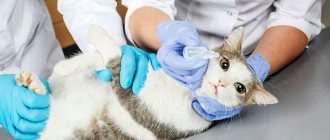Dangerous object
Among all domestic animals, the cat most often becomes the target of aggression by the human immune system. The point is not about any particular harmfulness of the cat family. An allergy is a mistake of the human immune system. His immune system suddenly begins to perceive ordinary, everyday factors as dangerous. The immune system launches real military operations to combat an external threat, triggering inflammatory reaction mechanisms, and does not calm down until the “dangerous object” disappears from the contact zone.
That is, the cause of allergies does not lie outside, it lies inside the person himself. Predisposition to allergies is written in genes. The more allergies there are in a family, the higher the chance of allergies in a child. But it is impossible to calculate in advance the likelihood of a disease and determine which factor will cause a reaction.
In general, “safety” advice for allergy sufferers sounds like this:
- If none of your family members have allergies, you don’t have to limit yourself in wanting to have a pet.
- If any family member is allergic to pollen, house dust, or food, it is not recommended to have a cat. There are no restrictions for other pets in this situation.
- And it is strictly not recommended to leave an animal to which you are already allergic.
How to check if there is an allergy to a specific cat? More details
Alarming symptoms:
An allergy to animals is manifested by a runny nose (with copious mucous discharge), redness of the conjunctiva of the eyes, lacrimation, and breathing problems (bronchospasm, suffocation). Such symptoms appear against the background of complete health upon contact with the animal or in the room where it is kept. With a very severe reaction, symptoms may appear even during communication with the owner of the animal (due to those particles of hair and animal epithelium that are always present on the clothes of people who have pets in their homes). Cat allergens are so persistent in the environment that even six months after parting with the animal they can still cause a reaction in people with allergic hypersensitivity.
Prevention of allergies in adults and children
For an adult. Often, the manifestation of the body’s reaction does not occur immediately. Often, by the time the problem is discovered, the cat has already firmly established itself as the universal favorite of the family; parting with it is completely excluded. In this case, you should follow a strict set of rules and hygienic restrictions, allowing a cat and an allergy sufferer to live in the same house:
- Conduct an audit of household utensils and furniture. Get rid of items made of fabric, wool, fur. Remove woolen blankets, rugs, rugs, and bedding.
- Keep the room clean, avoid accumulation of dust and cat hair. Wash floors regularly, clean the surfaces of furniture, paying special attention to the cat’s resting areas.
- All clothing and bedding must be stored in closets that are not accessible to your four-legged pet.
- Perform weekly bathing procedures with your cat.
- Every day, brush your pet's fur along the hairline with a pet brush with metal teeth. Throw away the combed fluff, having previously sealed it.
- Organize regular ventilation of the premises, use an air purifier to trap allergens (not to be confused with a air freshener!).
- Keep your cat litter clean by regularly changing the litter. It is advisable to use a closed tray as a toilet.
- Reduce the animal's interaction with allergy sufferers. Caregiving responsibilities must be performed by a healthy family member.
- The nursery and bedroom should be free of cat items (bowls, drinking bowls, toys).
- Your home medicine cabinet should always contain anti-allergy medications.
These simple rules need to be strictly followed to prevent exacerbations of allergic reactions and maintain a healthy and friendly atmosphere in the home.
For a child. How to overcome cat allergies in children? If a painful reaction of the body to a cat manifests itself in minor family members, children should be protected as much as possible from contact with the furry source of problems:
- The cat's passage into the children's bedroom must be closed once and for all;
- The child should learn to wash his hands with soap after each contact with the cat;
- The cat must be washed using special shampoos;
- The animal's toilet must be kept perfectly clean. The hygienic filler needs to be replaced after each use.
You should carefully monitor the symptoms of the disease: if attacks are rare and short-lived, strict compliance with all prescribed measures will reduce the risk to a minimum. In any case, the decision to have a furry family friend should be made after consultation with a doctor.
It's not about the wool!
Contrary to popular belief, cat fur does not have pronounced allergenic properties. The main cat allergens are protein compounds that are present in saliva, sebum, secretions, and exfoliated skin flakes. Cat hair is just a reservoir where allergens accumulate.
There are no hypoallergenic cats in nature. All stories about “special” cat breeds (for example, it is believed that Sphynxes and other hairless cats do not cause allergies) are either a marketing ploy by breeders or an honest misconception.
True, scientific research is now being conducted to reduce the allergenic properties of cats. One of the areas of work of scientists is attempts to breed a line of cats in which the production of the allergenic protein Fel d1 is genetically blocked. Another direction is the development of a special food that contains compounds that can bind Fel d1 in the animal’s body.
Question answer
Why do cats wag their tails with anger, and dogs with joy?
Complete list of hypoallergenic cat breeds
No. 1. Hairless cats
Everything is logical here, we found out that the allergen is the Fel D1 protein, with the help of wool it spreads throughout the house. No wool - no problem.
- Don Sphynx
- Canadian Sphynx
- Petersburg Sphynx (Peterbald)
- Ukrainian Levkoy
- Elf
- Bambino
No. 2. Shorthair breeds
Hairless cats are a wonderful option, but not everyone can get used to their unique beauty. If you are embarrassed by the lack of hair, you can take a closer look at short-haired breeds that produce fewer allergens.
- Devon rex
- Cornish Rex
- German Rex
- Likoy
There are also very ordinary-looking short-haired cats, which, for various reasons, are less allergenic than other breeds.
- Bengal cat
- Burmese cat
- Oriental cat
- Russian blue cat
No. 3. Long-haired hypoallergenic cat breeds
Yes, yes, it turns out there are such people. We remember that in theory, the length of the fur does not matter, because the allergic reaction is caused by the protein contained in the cat’s body, and the hairs only transfer the allergen. Our latest selection is living proof of this.
- Balinese cat (Balinese, Balinese cat) - this breed is called the long-haired Siamese, but unlike the Siamese, representatives of this breed produce fewer allergens.
- Yanvan cat (Yanvanese)
- Siberian cat - surprisingly, despite the luxurious fur coat, Siberians are hypoallergenic breeds; 75% of allergy sufferers do not have a reaction to them.
- Neva Masquerade - since this is a subspecies of the Siberian cat, they have the same number of allergens.
This is the list. Once again, there are no 100% non-allergenic cats, but many allergy sufferers have breeds from the list above. However, everything is very individual.
Source
Surely everyone has a friend or a friend of a friend who is allergic to cats. Contrary to popular belief that the human body reacts to animal fur, this is not true. It's all because of the protein, which is found in microscopic particles of the pet's skin, saliva and urine. As the cat walks around the house, washes its fur and plays with different objects, particles of this protein remain everywhere, but mostly on the fur. This is where the myth originated that cat fur causes an allergic reaction.
Assessing the risk
If you are deciding whether to get a pet, but are afraid of allergies, consult an allergist-immunologist. The doctor will be able to professionally assess the risk and, if necessary, prescribe an examination: skin tests and laboratory tests. Among laboratory studies, studies performed using cap technology deserve the greatest confidence.
Your own body will also be a good advisor. Before getting your own cat, try to socialize with other people's purrs. Monitor your well-being carefully. If upon contact with an animal discomfort occurs, itching in the nose, eyes, watery eyes, sore throat, this can be regarded as a manifestation of an allergy. Please note that there may be no symptoms at first. Sometimes it takes several weeks for a persistent allergic reaction to form.
The risk of developing allergies with a cat
What is the likelihood that a British kitten will be allergic when it comes into the home? No one can answer this question for sure. It all depends on the individual characteristics of each person’s immunity. Of course, if a person is prone to allergies, is weakened by illness, or takes certain medications, the appearance of a British cat may be more likely to cause allergies. If a person is generally strong and healthy, then an allergy to British cats is less likely.
Rate and share!
Choosing a kitten
The amount of allergens produced by different cats varies.
Kittens are less likely to cause allergies than adult cats. The baby’s body is not yet formed, and they secrete fewer specific proteins. Therefore, even if the kitten does not cause an allergic reaction, it is too early to relax.
The production of allergen proteins depends on the cat’s hormonal background, so sterilized animals are less likely to cause unwanted reactions.
Animals with light fur are less likely to cause allergies than dark-colored cats. Scientists do not yet know why this is so, but there is a version that the amount of allergen proteins secreted by a cat depends on the pigmentation of the coat.
But the length of the coat does not affect the number of allergens, but the thickness does. The thicker the undercoat, the more sebum and skin particles it accumulates. But, even if you choose a snow-white cat and sterilize it, there is no guarantee that there will be no allergic reaction.
Not a good apartment. What should an allergy sufferer fear in their own home? Read more
How to get rid of cat allergies
“There is allergen-specific immunotherapy,” comments allergist-immunologist Anna Kapustina. — It involves the introduction of an allergen into the body in gradually increasing doses. Therapy helps reduce allergy symptoms or get rid of them completely. But in Russia, drugs for ASIT with cat allergens have not yet been registered.”
pixabay.com/
Therefore, allergists advise placing your pet in good hands. Unfortunately, there is no other way to get rid of an allergic reaction. If this is not possible, try to limit the contact of the allergic person with the pet as much as possible and follow these rules.
- Do not pick up the animal. Do not pet him, do not let him into the bedroom, and especially not on the bed.
- Use a humidifier. Allergens can remain suspended in the air for a long time. Air humidification causes microparticles to swell and increase in volume, causing them to fall to the floor or furniture.
- Do wet cleaning. As often as possible, at least three times a week. It is important to wipe with a damp cloth not only the floor, but also furniture, window sills, flower leaves, that is, all surfaces on which allergenic particles can linger.
- Review the furnishings of your apartment. Get rid of carpets where allergens linger for a long time and it is extremely difficult to remove them from the pile. Replace furniture with textile upholstery with armchairs and sofas with leather or leatherette covers that can be washed regularly. Remove curtains and floor lamps with fabric lampshades. The space should be such that any surface can be easily wiped with a damp cloth.
You need to wash your cat daily, just with water from the shower without shampoo. Water washes away allergenic particles from the fur and makes the pet safer for allergy sufferers. But even this procedure is dangerous if you are prone to allergies, so entrust the care of the animal to a family member who does not suffer from an allergic reaction.
It will go away on its own
It happens that an allergic reaction to cats disappears over time on its own. The immune system seems to “get used” to the allergen and ceases to consider it dangerous. But, alas, such a happy outcome is relatively rare - it occurs in approximately 20% of allergy sufferers. The rest will have to either part with their pet or take medication for life.
Allergen-specific immunotherapy (ASIT), which gradually “accustoms” the body to the allergen and is successfully used, for example, to treat hay fever, is not yet used for the treatment of cat allergies in Russia. However, the ASIT vaccine against cat allergies is undergoing registration in the Russian Federation. That is, it is a matter of time.
When can signs be deceiving?
The symptoms of cat allergy in children and adults are very similar to a number of other allergic reactions. Therefore, do not rush to give your pet away, because the reason may not be his:
- The reaction can be caused not by the pet, but by its accessories: food, shampoo, litter
- Animals that walk outside can carry particles of pollen or mold on their fur, which are strong allergens.
- A cat can infect its owner with an infection (lichen, scabies mite), which causes symptoms similar to allergies
Therefore, you should not engage in self-diagnosis, but rather consult a doctor. He will prescribe diagnostics (skin tests or blood tests) that will accurately determine the cause of the allergic reaction.
There are two ways to determine allergies - by blood test and by skin testing. Skin tests can be either superficial: applying the allergen to scratched skin, or injection: injecting it under the patient’s skin. All procedures are carried out under the supervision of an allergist to monitor the patient’s condition.
The skin reaction usually appears approximately 30 minutes after the start of the test. A blood test is used when the age or health of the patient does not allow skin testing. This allows you to minimize risks. The blood test is done over several days.
If you still want
According to statistics, a third of all people allergic to cats decide to take a risk and bring a mustachioed friend into their family. Sometimes the choice falls on Scottish Fold kittens. To protect yourself from possible allergies, you need to thoroughly prepare before taking a pet into your home.
First of all, you need to take into account that less protein is produced in the body of cats with a light color. It is not yet known exactly why this happens - perhaps the genotype of individuals with light hair influences protein synthesis.
Males produce more allergen than females. Therefore, if you want to have a Scottish fold kitten, it is better to choose a female of white, lilac, red or cream color.
Important! Kittens produce several times less protein, so allergies may not occur immediately, but after some time.
The degree of protein production also depends on the individual characteristics of a particular cat. Many allergy sufferers notice that they can freely communicate with some kittens, hold them in their arms, play, while others make them cry and sneeze as soon as they appear in the room, and this does not depend on the breed or length of fur.
The easiest option is to come to the nursery and spend some time with the kitten you like. However, even if an allergy to Scottish kittens does not appear, no one can guarantee that it will not appear later, since in childhood cats usually do not cause problems for allergy sufferers. The breeder may assure you that everything will be fine - you don't sneeze while you are in the same room with the animal - but assumptions alone are not enough.
Those who want to approach the issue responsibly can take a test from an allergist. To do this, you need to take with you a hair from the kitten you like, from which the doctor can isolate the genotype. It creates a solution that is then dropped onto a small scratch on your forearm. After 15-20 minutes, the reaction is assessed, based on which the allergist can tell whether the selected kitten is dangerous for you.
Some people manage to train their body to calmly treat a particular cat. If the allergy to Scottish cats is mild, then you only need to play with the animal from time to time, allowing it to scratch you, but not too much. As a result, the allergen will enter the blood, but in a small concentration. If this happens regularly, then the immune system may come to terms with your decision to have a kitten, but the allergy to other animals will remain the same.
Important! If the allergy is pronounced, such experiments are unacceptable - they can cause complications, including anaphylactic shock.
Clinical researches
La-Cri products are clinically proven effective. For example, clinical studies have proven the effectiveness, safety and tolerability of the products. The products are suitable for daily care of children's skin with mild to moderate forms of atopic dermatitis and during remission, accompanied by a decrease in the quality of life of patients.
La-Cri cosmetics, according to research results, are recommended by the Russian Union of Pediatricians.
Sources:
- Schneiderman Paul, Grossman Mark, Differential diagnosis in dermatology. Atlas, Binom, 2021.
- Molochkova Yulia Vladimirovna, Dermatology. Brief reference book, GEOTAR-Media, 2021.
- Sukolin Gennady Ivanovich, Clinical dermatology. A short guide to the diagnosis and treatment of dermatoses, Notabene, 2017.
Diagnostics
First of all, you need to donate blood to determine specific IgE and IgG antibodies. There are also skin tests. The essence of the test is simple: the doctor makes small scratches on the patient’s skin and alternately injects different types of allergens into them. Based on the swelling and redness, it will be possible to conclude which substance provokes the allergic reaction.
The doctor performs allergy tests. Photo: belchonock/Depositphotos
Sometimes an allergy is caused not by the cat itself, but by food, litter, or plant pollen that badgers and murkas can bring from the street. This is more true for cats walking in the yard, but even regular walks on the veranda are also a certain risk factor.
In addition, there are diseases that are similar in symptoms to allergies, but have a completely different origin (for example, conjunctivitis or rhinitis). That is why it is important to undergo the entire range of diagnostic tests.
How the cat caused a scandal
Scientists have been trying to develop a hypoallergenic cat breed for years.
In 2004, such an ambitious project was announced by the American company Allerca. Initially, it was planned to conduct experiments in the field of genetic engineering, but then company representatives decided to focus on a cheaper option - breeding. They found a cat, Joshua, whose secretions from the salivary and sebaceous glands contained record low amounts of Fel d 1 and Fel d 4 proteins. It was assumed that kittens born from Joshua would inherit his feature. Already in 2006, the company announced the sale of a new breed of kittens, bred specifically for allergy sufferers. The cost of one kitten reached 7,000 US dollars. At the same time, Allerca warned that the kittens are not 100% hypoallergenic, but 96%. In the end, it all ended in a big scandal, since it turned out that the owners of these pets had all the symptoms characteristic of an allergy to cats.
Prevention
To minimize the risk of allergic reactions, you should wash your hands after handling your cat and try not to stay in the same room with it for a long time. It is also important not to forget to ventilate all rooms in the house. If possible, you should limit your diet to foods that cause sensitization (increased sensitivity of the body to allergens). These products include:
- Strawberry wild-strawberry;
- honey;
- alcoholic drinks;
- nuts and peanuts;
- seafood;
- spicy and smoked dishes;
- chocolate, cocoa;
- canned foods;
- radish;
- horseradish;
- tomatoes;
- eggplant.
Currently, American scientists are developing a special additive to cat food, which, with long-term use, will reduce the activity of the Fel d 1 allergen to a minimum⁵. The first laboratory tests gave positive results. If subsequent studies confirm the effectiveness of the supplement, it will soon go on sale.











